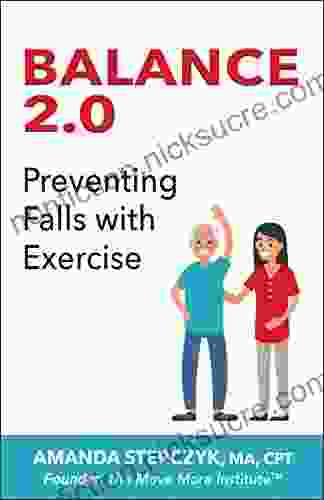Preventing Falls: Essential Exercises and Balance Training for Fall Prevention

4.4 out of 5
| Language | : | English |
| File size | : | 3261 KB |
| Text-to-Speech | : | Enabled |
| Screen Reader | : | Supported |
| Enhanced typesetting | : | Enabled |
| Word Wise | : | Enabled |
| Print length | : | 102 pages |
| Lending | : | Enabled |
Falls are a major public health concern, particularly among older adults. According to the Centers for Disease Control and Prevention (CDC),falls are the leading cause of injury-related deaths among adults aged 65 and older, with over 3 million emergency department visits and 300,000 hospitalizations annually. Falls can have severe consequences, including physical injury, loss of independence, and reduced quality of life.
The good news is that falls are preventable. Exercise and balance training are essential foundations for fall prevention, and this article will provide a comprehensive guide to effective strategies for reducing fall risk.
Risk Factors for Falls
Several risk factors increase the likelihood of falling, including:
- Age: The risk of falling increases with age, as balance and coordination decline naturally.
- Muscle weakness: Weak leg muscles make it difficult to maintain balance and recover from a loss of balance.
- Poor balance: Balance is essential for maintaining stability and preventing falls.
- Gait problems: Walking or standing difficulties can increase the risk of tripping or stumbling.
- Sensory impairments: Vision and hearing problems can affect balance and coordination.
- Cognitive impairment: Dementia or other cognitive impairments can impair judgment and increase fall risk.
- Medications: Certain medications, such as sedatives or antidepressants, can cause dizziness or drowsiness, increasing the risk of falling.
- Environmental hazards: Slippery floors, poor lighting, or uneven surfaces can increase the risk of falls.
Exercise and Balance Training for Fall Prevention
Exercise and balance training can effectively reduce fall risk by improving strength, balance, and gait. Here are some essential exercises and training principles:
Strength Training
Strength training helps build muscle strength, which is essential for maintaining balance and recovering from a loss of balance. Focus on exercises that strengthen the legs, core, and upper body muscles.
- Squats: Hold a dumbbell or kettlebell in each hand and lower your body into a squat position, keeping your back straight and knees aligned with your toes.
- Lunges: Step forward with one leg and bend both knees, lowering your body until your thigh is parallel to the floor. Keep your front knee aligned with your ankle and your back knee from touching the ground.
- Planks: Hold a plank position on your forearms, keeping your body in a straight line from head to heels. Engage your core and hold for as long as possible.
- Push-ups: Start in a plank position and lower your body by bending your elbows, keeping your back straight and core engaged.
Balance Training
Balance training improves the ability to maintain stability and recover from a loss of balance. Start with simple exercises and gradually increase the challenge.
- Single-leg stance: Stand on one leg for as long as possible, keeping your other leg slightly bent and off the ground.
- Heel-toe walking: Walk forward by placing your heel directly in front of your toes.
- Side-to-side walking: Walk sideways, taking small steps and keeping your feet flat on the ground.
- Tai chi: Tai chi is a mind-body practice that involves gentle movements and balance challenges.
Gait Training
Gait training improves walking and standing stability, reducing the risk of tripping or stumbling. Focus on exercises that improve stride length, cadence, and postural control.
- Walking with a cane or walker: Use a cane or walker to provide additional support and stability while walking.
- Walking with a partner: Walk with a partner for support and assistance if needed.
- Heel-toe walking: Walk forward by placing your heel directly in front of your toes.
Proprioception Training
Proprioception is the ability to sense the position of the body in space. Impaired proprioception can increase fall risk. Exercises that challenge proprioception can improve balance and stability.
- Balance board: Stand on a balance board and try to maintain your balance while the board moves.
- Closed-eye stance: Stand with your feet shoulder-width apart and close your eyes. Try to maintain your balance for as long as possible.
- Toe taps: Stand with your feet shoulder-width apart and tap your toes to the ground in front of you, behind you, and to the sides.
Other Fall Prevention Strategies
In addition to exercise and balance training, other strategies can help prevent falls:
- Home safety modifications: Remove tripping hazards such as loose rugs or cords. Install grab bars in the bathroom and shower. Ensure adequate lighting throughout the home.
- Assistive devices: Canes, walkers, and wheelchairs can provide additional support and stability.
- Regular eye exams: Vision impairments can increase fall risk. Regular eye exams can ensure proper vision correction.
- Medication review: Certain medications can cause dizziness or drowsiness, increasing fall risk. Talk to your doctor about reviewing your medications.
- Fall risk assessment: A healthcare professional can assess your fall risk and provide personalized recommendations for prevention.
Falls are a serious public health concern, especially among older adults. However, falls are preventable, and exercise and balance training are essential foundations for fall prevention. By incorporating these exercises and strategies into your routine, you can significantly reduce your risk of falling and maintain your mobility and independence as you age.
Remember to consult with your healthcare provider before starting any new exercise program, especially if you have any underlying health conditions.
4.4 out of 5
| Language | : | English |
| File size | : | 3261 KB |
| Text-to-Speech | : | Enabled |
| Screen Reader | : | Supported |
| Enhanced typesetting | : | Enabled |
| Word Wise | : | Enabled |
| Print length | : | 102 pages |
| Lending | : | Enabled |
Do you want to contribute by writing guest posts on this blog?
Please contact us and send us a resume of previous articles that you have written.
 Fiction
Fiction Non Fiction
Non Fiction Romance
Romance Mystery
Mystery Thriller
Thriller SciFi
SciFi Fantasy
Fantasy Horror
Horror Biography
Biography Selfhelp
Selfhelp Business
Business History
History Classics
Classics Poetry
Poetry Childrens
Childrens Young Adult
Young Adult Educational
Educational Cooking
Cooking Travel
Travel Lifestyle
Lifestyle Spirituality
Spirituality Health
Health Fitness
Fitness Technology
Technology Science
Science Arts
Arts Crafts
Crafts DIY
DIY Gardening
Gardening Petcare
Petcare Rachel Swaby
Rachel Swaby Christian Bates
Christian Bates Elizabeth Swire Falker
Elizabeth Swire Falker Nico Medina
Nico Medina Christine H Morton
Christine H Morton Simone Abram
Simone Abram Irene Mchenry
Irene Mchenry Sam Jarman
Sam Jarman Nancy Cartwright
Nancy Cartwright Thomas Norman Dewolf
Thomas Norman Dewolf Keely Hutton
Keely Hutton Donna R Causey
Donna R Causey R A Palmer
R A Palmer Robin Dunbar
Robin Dunbar Chris Donaldson
Chris Donaldson Charlie Walker
Charlie Walker Ronojoy Sen
Ronojoy Sen Mike White
Mike White Johannes Krause
Johannes Krause Chloe Howard
Chloe Howard Curtis Retherford
Curtis Retherford Celeste Shally
Celeste Shally John Galeano
John Galeano Stuart A Klugman
Stuart A Klugman Jessica Ashley
Jessica Ashley Laurie Seale
Laurie Seale Theron Hopkins
Theron Hopkins Tracy Donegan
Tracy Donegan James Morgan Ayres
James Morgan Ayres Lynette Noni
Lynette Noni David Goudsward
David Goudsward Kindle Edition
Kindle Edition Dan Buettner
Dan Buettner Megan Miller
Megan Miller Bill Fawcett
Bill Fawcett Steve Jamison
Steve Jamison Rachel Simmons
Rachel Simmons Edward Bulwer Lytton
Edward Bulwer Lytton Keith Ryan Cartwright
Keith Ryan Cartwright Heather Jacobson
Heather Jacobson Team Golfwell
Team Golfwell Ross Bentley
Ross Bentley Bill Douglas
Bill Douglas Summary Genie
Summary Genie William Wasserman
William Wasserman Kailyn Lowry
Kailyn Lowry Mark Bacera
Mark Bacera Elizabeth Noble
Elizabeth Noble Danielle Paige
Danielle Paige Helen Barry Siragusa
Helen Barry Siragusa Kevin C Kelleher Md Md
Kevin C Kelleher Md Md Peter Owen
Peter Owen Amanda Sterczyk
Amanda Sterczyk Sarah Zettel
Sarah Zettel Michael Digiacomo
Michael Digiacomo Nancy K O Leary
Nancy K O Leary Hal Herzog
Hal Herzog Jane Bottomley
Jane Bottomley Patrice Karst
Patrice Karst Miles Howard
Miles Howard Ennki Hakari
Ennki Hakari Susan Campbell Bartoletti
Susan Campbell Bartoletti Cindy Ross
Cindy Ross Isle Osaki
Isle Osaki Kristin Cashore
Kristin Cashore Dave Wilson
Dave Wilson Albert Gallatin Mackey
Albert Gallatin Mackey Sammy Franco
Sammy Franco Michael J Leahy
Michael J Leahy G Bruce Knecht
G Bruce Knecht Patrick Sweeney
Patrick Sweeney Jane Watkins
Jane Watkins Joanna Grace
Joanna Grace Paul Carus
Paul Carus Ross Campbell
Ross Campbell Tony J Bell
Tony J Bell Iman Hami
Iman Hami Jennifer M Sparks
Jennifer M Sparks Joshua Berman
Joshua Berman Robin Donovan
Robin Donovan Kate Pankhurst
Kate Pankhurst Michael Banton
Michael Banton Genie Reads
Genie Reads Nick Muxlow
Nick Muxlow James Rushforth
James Rushforth Joanna Pruess
Joanna Pruess Paul Farmer
Paul Farmer Jennifer Kolari
Jennifer Kolari Karl Polanyi
Karl Polanyi Dermot Moran
Dermot Moran Sabaa Tahir
Sabaa Tahir Grant Cunningham
Grant Cunningham Sport Hour
Sport Hour Jacques Steinberg
Jacques Steinberg Dominic O Brien
Dominic O Brien Debbie M Schell
Debbie M Schell Todd Eklof
Todd Eklof Steve Hagen
Steve Hagen Larry Olmsted
Larry Olmsted Stefanie Reinhold
Stefanie Reinhold Marie Mance
Marie Mance David A Clark
David A Clark Duncan Wells
Duncan Wells Victoria E Kress
Victoria E Kress Doc Severson
Doc Severson Mariamelys Yanez
Mariamelys Yanez John Flanagan
John Flanagan Penny Simkin
Penny Simkin David J Hand
David J Hand Erika Buenaflor M A J D
Erika Buenaflor M A J D Anya Hayes
Anya Hayes Cory Mccartney
Cory Mccartney Reemus Boxing
Reemus Boxing Richard Wiseman
Richard Wiseman Stephanie Clarke
Stephanie Clarke Stephen J Bavolek
Stephen J Bavolek Jenny Han
Jenny Han Sean Herman
Sean Herman Suzy Favor Hamilton
Suzy Favor Hamilton Baz Thompson
Baz Thompson Kevin Dutton
Kevin Dutton Tamara Ferguson
Tamara Ferguson Patrick Mcallister
Patrick Mcallister Alejandro Sequera
Alejandro Sequera Jen L Grey
Jen L Grey John H Hanson
John H Hanson Rachel Dickinson
Rachel Dickinson W H C Bassetti
W H C Bassetti Cgp Books
Cgp Books Dina Rudick
Dina Rudick Lester Kaufman
Lester Kaufman Henry Hatcher
Henry Hatcher Lewis Hyde
Lewis Hyde Marie Louise
Marie Louise Jules Verne
Jules Verne Janna Cawrse Esarey
Janna Cawrse Esarey Susan Brink
Susan Brink Elizabeth Fein
Elizabeth Fein Preston Peet
Preston Peet Paul Nash
Paul Nash Christopher Ives
Christopher Ives Les Stroud
Les Stroud John Mccollister
John Mccollister Samaire Wynne
Samaire Wynne Michael J Bennett
Michael J Bennett Steve Brill
Steve Brill Anton Szandor Lavey
Anton Szandor Lavey Misty Jordyn
Misty Jordyn Dennis Fisher
Dennis Fisher Daniel Lenihan
Daniel Lenihan Quad Webb
Quad Webb Christopher Scott
Christopher Scott Chris Gosden
Chris Gosden Mike Kephart
Mike Kephart Dr Robert Demaria
Dr Robert Demaria Nathan Holder
Nathan Holder Dale H Schunk
Dale H Schunk Blake Dresden
Blake Dresden Jay Mccullough
Jay Mccullough Christopher Pike
Christopher Pike Emma Griffin
Emma Griffin Richard Berry
Richard Berry Lefty Kreh
Lefty Kreh John Volanthen
John Volanthen Richard Louv
Richard Louv Peterson S
Peterson S Jim Cobb
Jim Cobb Sam Chenery Morris
Sam Chenery Morris Clara Dehlin
Clara Dehlin Theodore Gray
Theodore Gray Don J Snyder
Don J Snyder Vassos Alexander
Vassos Alexander Jay Hoffman
Jay Hoffman Tim Harford
Tim Harford Jeffrey John Kripal
Jeffrey John Kripal Dan Reeder
Dan Reeder Dr Amanda Kemp
Dr Amanda Kemp Marie Viljoen
Marie Viljoen Matt Brown
Matt Brown Chris Riddell
Chris Riddell Stephen Brennan
Stephen Brennan Kaplan Test Prep
Kaplan Test Prep Becky Kopitzke
Becky Kopitzke Grant Andrews
Grant Andrews Reid Henrichs
Reid Henrichs Jennifer Mind
Jennifer Mind Michael Blackburn
Michael Blackburn Margot De Sevo
Margot De Sevo John R Weisz
John R Weisz Asato Asato
Asato Asato Robert W Sussman
Robert W Sussman Law School Admission Council
Law School Admission Council Jason Reynolds
Jason Reynolds Ethan Bezos
Ethan Bezos Ryan Robert
Ryan Robert Mindy Mcginnis
Mindy Mcginnis Kenny Dill
Kenny Dill Kat Howard
Kat Howard Larry Flax
Larry Flax Dave Canterbury
Dave Canterbury Ronald Williams
Ronald Williams Robert F Moss
Robert F Moss Greg Wyshynski
Greg Wyshynski John E Phillips
John E Phillips Natalie C Parker
Natalie C Parker Shauna L Shapiro
Shauna L Shapiro Tania Israel
Tania Israel Johannes W Rohen
Johannes W Rohen Denise Alvarado
Denise Alvarado Randall Bell
Randall Bell Randy Smith
Randy Smith Dave Bergman
Dave Bergman Richard Bronson
Richard Bronson Henry E Mejia
Henry E Mejia Christophe Morin
Christophe Morin P C Cast
P C Cast Chrissie Wellington
Chrissie Wellington Kay Gill
Kay Gill Patrick M Browning
Patrick M Browning Jim Al Khalili
Jim Al Khalili Martin E P Seligman
Martin E P Seligman Elizabeth Grosz
Elizabeth Grosz David Baldacci
David Baldacci Mary Catherine Bateson
Mary Catherine Bateson Jenna Helland
Jenna Helland Patricia Burroughs
Patricia Burroughs Matt Lewis
Matt Lewis Katy Madison
Katy Madison Martin W Ball
Martin W Ball Katlin Middleton
Katlin Middleton Georg Rauch
Georg Rauch Jay Walden
Jay Walden Tina Basich
Tina Basich Craig Pittman
Craig Pittman Julia Miele Rodas
Julia Miele Rodas Michelle Cree
Michelle Cree Charlie Francis
Charlie Francis Daniel Holzman
Daniel Holzman Nitin Guptta
Nitin Guptta Jon Sherman
Jon Sherman Glen Heggstad
Glen Heggstad Lindsay Helm
Lindsay Helm Patrick Schulte
Patrick Schulte John Trent
John Trent William Macaskill
William Macaskill Patrick Linsenmeyer
Patrick Linsenmeyer Sir John Franklin
Sir John Franklin Howard Markel
Howard Markel Marlo Gottfurcht Longstreet
Marlo Gottfurcht Longstreet Louise Greenspan
Louise Greenspan Jacqueline Melvin
Jacqueline Melvin Hal Roth
Hal Roth Martina Sprague
Martina Sprague Maria Del Russo
Maria Del Russo Ken Setterington
Ken Setterington Eden O Neill
Eden O Neill Gish Jen
Gish Jen Jessica Beck
Jessica Beck Marlo Payne Thurman
Marlo Payne Thurman Lawrence Schiller
Lawrence Schiller Cheryl Kimball
Cheryl Kimball N J Enfield
N J Enfield Terence Mclaughlin
Terence Mclaughlin Nicole Conway
Nicole Conway Clair Lasater
Clair Lasater Michael Lempert
Michael Lempert Lina Chang
Lina Chang Sandy Gingras
Sandy Gingras Rachel Morgan
Rachel Morgan David Grant Noble
David Grant Noble Yuri Ulengov
Yuri Ulengov Christiane F
Christiane F Denise Wiesner
Denise Wiesner Peter Koning
Peter Koning Pam Coburn
Pam Coburn Lynn Melnick
Lynn Melnick Nancy Northcott
Nancy Northcott Mark Hatala
Mark Hatala Stephanie Dueger
Stephanie Dueger William H Shellenberger
William H Shellenberger Zara Fagen
Zara Fagen Ronald Wright
Ronald Wright Rebecca Rather
Rebecca Rather The Princeton Review
The Princeton Review Christopher Clarey
Christopher Clarey Ron Maly
Ron Maly Ken Palmer
Ken Palmer Phil Dunmeyer
Phil Dunmeyer Kahlil Gibran
Kahlil Gibran Jason Frye
Jason Frye Harry K Mcevoy
Harry K Mcevoy Pavla Kesslerova
Pavla Kesslerova Liz Arch
Liz Arch Laura Sebastian
Laura Sebastian Russ Harris
Russ Harris Sean Fister
Sean Fister Jonathan Wolf
Jonathan Wolf Tommy Hicks
Tommy Hicks Nick Fragel
Nick Fragel Catherine Carrigan
Catherine Carrigan Patrick Vinton Kirch
Patrick Vinton Kirch Peter Townsend
Peter Townsend J Phillip Stonewater
J Phillip Stonewater Richard A Horsley
Richard A Horsley Catherine Legrand
Catherine Legrand Tahir Shah
Tahir Shah Stefanie Weisman
Stefanie Weisman Christopher Barile
Christopher Barile Brock Eide
Brock Eide Tara Isabella Burton
Tara Isabella Burton Peter Canning
Peter Canning Paula Derr
Paula Derr Tessa Broad
Tessa Broad Haylie Duff
Haylie Duff Michael Plymel
Michael Plymel Joseph A Mccullough
Joseph A Mccullough Paul Bellow
Paul Bellow Delaney Ruston
Delaney Ruston Trevor Thomas
Trevor Thomas Klaus Dodds
Klaus Dodds Maggie Oakes
Maggie Oakes Darren Levine
Darren Levine Jeff Henigson
Jeff Henigson Cliff Harris
Cliff Harris Dawn M Mcbride
Dawn M Mcbride Johann Weyer
Johann Weyer Dodie Smith
Dodie Smith Heather A Smith
Heather A Smith Konstantinos Mylonas
Konstantinos Mylonas J Bruce Brackenridge
J Bruce Brackenridge Theodora Papatheodorou
Theodora Papatheodorou Keith Gave
Keith Gave Steven D Fleming
Steven D Fleming Arrl Inc
Arrl Inc Kathryn Harkup
Kathryn Harkup Samuel T Heart
Samuel T Heart Stephanie Evans
Stephanie Evans Robert Macfarlane
Robert Macfarlane Tim Cammisa
Tim Cammisa Rui Zhi Dong
Rui Zhi Dong Sophie Delaplaine
Sophie Delaplaine Rob Neyer
Rob Neyer Jaime Aron
Jaime Aron Schuld
Schuld Quick Reads
Quick Reads Michael Mccreary
Michael Mccreary Dave King
Dave King Cora Rivers
Cora Rivers David J Cox
David J Cox Marlene Laruelle
Marlene Laruelle Malcolm Pearson
Malcolm Pearson Joan Naidorf
Joan Naidorf Nathan Fox
Nathan Fox Sara Woods
Sara Woods Chris Mccormack
Chris Mccormack Wendell Berry
Wendell Berry Maryse Cardin
Maryse Cardin Robin Hanson
Robin Hanson Judy Bartkowiak
Judy Bartkowiak Stephen R Bown
Stephen R Bown Mantak Chia
Mantak Chia Elsevier
Elsevier J Franklin Snyder
J Franklin Snyder Glenn Doman
Glenn Doman David Miller
David Miller James F Clapp
James F Clapp Booksumo Press
Booksumo Press Kevin Muramatsu
Kevin Muramatsu Dan Flores
Dan Flores Lisa Gache
Lisa Gache Sydney George Fisher
Sydney George Fisher Paddy Dillon
Paddy Dillon Nelson Simon
Nelson Simon Suzanne Young
Suzanne Young Mohamed F El Hewie
Mohamed F El Hewie Kaiser Fung
Kaiser Fung Sjaak Laan
Sjaak Laan Bill Patton
Bill Patton Richard S Westfall
Richard S Westfall Rough Guides
Rough Guides Michael Medved
Michael Medved Nicole Galan
Nicole Galan Dahlia Adler
Dahlia Adler Arthur Hsieh
Arthur Hsieh Simon Monk
Simon Monk Jessica Lander
Jessica Lander Randall Hicks
Randall Hicks Melinda Tankard Reist
Melinda Tankard Reist Ian Wilson
Ian Wilson June Alexander
June Alexander Shelly Crane
Shelly Crane Mark Hansen
Mark Hansen Ron Kaspriske
Ron Kaspriske Dk
Dk Mike Schultz
Mike Schultz John Allen
John Allen Daniel Loxton
Daniel Loxton Nancy Carter Crump
Nancy Carter Crump Brother Nero
Brother Nero Lane Rebelo
Lane Rebelo John T Moore
John T Moore Harry Bruinius
Harry Bruinius Viviana Gyori
Viviana Gyori Jack Burns
Jack Burns Don Casey
Don Casey Felix Eshesimua
Felix Eshesimua Stella Cottrell
Stella Cottrell Sally M Foster
Sally M Foster Johnjoe Mcfadden
Johnjoe Mcfadden National Fastpitch Coaches Association
National Fastpitch Coaches Association Kevan Harris
Kevan Harris Rowan Blanchard
Rowan Blanchard Michelle D Swaney
Michelle D Swaney Patrick Garbin
Patrick Garbin Esther M Toddler
Esther M Toddler Marsha Vanwynsberghe
Marsha Vanwynsberghe Stuart Mcrobert
Stuart Mcrobert Glinda Porter
Glinda Porter Kenneth Rideout
Kenneth Rideout Jonathan Beverly
Jonathan Beverly Sarah Bennett
Sarah Bennett Charmaine Mckissock
Charmaine Mckissock Evy Poumpouras
Evy Poumpouras Jens Meyer
Jens Meyer Sonja Renee
Sonja Renee Creek Stewart
Creek Stewart Cecil Harris
Cecil Harris Jo A Kaucher
Jo A Kaucher Jeff Carreira
Jeff Carreira Trevelyan
Trevelyan Amanda Phillips
Amanda Phillips Rachel Griffin
Rachel Griffin James Stewart
James Stewart Warrior Primal
Warrior Primal Thomas C Foster
Thomas C Foster Chris Crutcher
Chris Crutcher Warren Ellis
Warren Ellis Scott O Morton
Scott O Morton James O Aldrich
James O Aldrich Lee A Wilkinson
Lee A Wilkinson Erika Stalder
Erika Stalder Katie Schnack
Katie Schnack Treehouse Books
Treehouse Books Kati Kleber
Kati Kleber Bob Bell
Bob Bell John Weir
John Weir Creative Task
Creative Task Stephanie Greer
Stephanie Greer Joel Greenberg
Joel Greenberg Thomas Daniels
Thomas Daniels David L Vance
David L Vance Jim Parks
Jim Parks Delia Owens
Delia Owens Conrad Fischer
Conrad Fischer Naomi Shihab Nye
Naomi Shihab Nye Jon Emmett
Jon Emmett Karen Horney
Karen Horney Frank Close
Frank Close Grace Mccready
Grace Mccready Hwei P Hsu
Hwei P Hsu King Heiple
King Heiple Ryan Skinner
Ryan Skinner Michael Whitehead
Michael Whitehead Zoe Mckey
Zoe Mckey Margalis Fjelstad
Margalis Fjelstad Clifford Geertz
Clifford Geertz Kevin Estela
Kevin Estela Print Replica Kindle Edition
Print Replica Kindle Edition John Schwartz
John Schwartz Mark Golds
Mark Golds Gareth Thomas
Gareth Thomas Jennifer Ward
Jennifer Ward Chris Fitch
Chris Fitch Dr Sandeep Jatwa
Dr Sandeep Jatwa Christopher Heaney
Christopher Heaney Daniel S Newman
Daniel S Newman Roald Amundsen
Roald Amundsen Kevin Neary
Kevin Neary Drew Clifton
Drew Clifton Richard E Silverman
Richard E Silverman Frank Runles
Frank Runles Scott Lanning
Scott Lanning Frederick Courteney Selous
Frederick Courteney Selous Havilah Babcock
Havilah Babcock John C Gordon
John C Gordon Hakim Isler
Hakim Isler Pastor Ahyh
Pastor Ahyh Jasper Kent
Jasper Kent Chris Jake
Chris Jake S Meloni M D
S Meloni M D Sig Hansen
Sig Hansen Len Mcdougall
Len Mcdougall Nicholas Sparks
Nicholas Sparks Mike Swedenberg
Mike Swedenberg John Hoskison
John Hoskison Scott H Sicherer
Scott H Sicherer Greg Stucky
Greg Stucky Dr Rex S Vanderwood
Dr Rex S Vanderwood S L Watson
S L Watson Louis Turjanen
Louis Turjanen Michael Paduch
Michael Paduch Karla Marie Williams
Karla Marie Williams Susan K Grove
Susan K Grove Doug Gaskill
Doug Gaskill Leland Chant
Leland Chant Tricia Levenseller
Tricia Levenseller Ronni Lundy
Ronni Lundy
Light bulbAdvertise smarter! Our strategic ad space ensures maximum exposure. Reserve your spot today!

 Truman CapoteAdventures of Mathematician Lynn Melnick: A Journey of Boundaries and Bridges
Truman CapoteAdventures of Mathematician Lynn Melnick: A Journey of Boundaries and Bridges
 August HayesAn Illustrated Exploration of Elements, Molecules, and Change in the Universe
August HayesAn Illustrated Exploration of Elements, Molecules, and Change in the Universe Evan HayesFollow ·6.8k
Evan HayesFollow ·6.8k Tennessee WilliamsFollow ·14k
Tennessee WilliamsFollow ·14k Abe MitchellFollow ·15.2k
Abe MitchellFollow ·15.2k Jace MitchellFollow ·2k
Jace MitchellFollow ·2k Trevor BellFollow ·9.2k
Trevor BellFollow ·9.2k Jamison CoxFollow ·2.9k
Jamison CoxFollow ·2.9k Terry BellFollow ·15.6k
Terry BellFollow ·15.6k Garrett PowellFollow ·2.4k
Garrett PowellFollow ·2.4k

 Jarrett Blair
Jarrett BlairThe Science Of Horror: Unmasking the Neuroscience Behind...
Horror, a genre that...

 Braden Ward
Braden WardIce Cream with Daddy: A Sweet and Savory Summer Memory
Ice cream with daddy...

 Daniel Knight
Daniel KnightThe Beginner's Guide to Must-Know Memory Tricks to Pass...
Are you a nursing...

 Kazuo Ishiguro
Kazuo IshiguroASAP Government Politics: A Comprehensive Analysis of Its...
In recent years, there has...

 Neal Ward
Neal WardTales From The Denver Broncos Sideline: An Unforgettable...
The Broncos' Unwavering Spirit The...
4.4 out of 5
| Language | : | English |
| File size | : | 3261 KB |
| Text-to-Speech | : | Enabled |
| Screen Reader | : | Supported |
| Enhanced typesetting | : | Enabled |
| Word Wise | : | Enabled |
| Print length | : | 102 pages |
| Lending | : | Enabled |










